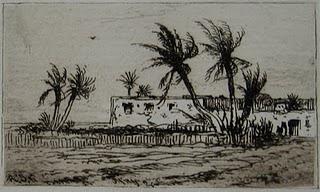 R. Swain Gifford, Algerian Landscape(The first plate etched at the New York Etching Club)Etching, 1877
R. Swain Gifford, Algerian Landscape(The first plate etched at the New York Etching Club)Etching, 1877The moment when that "first-born" proof emerged from Smillie's press heralded the dawn of the American Etching Revival, or the American Painter-Etcher Movement, which saw a craze for both making and collecting etchings sweep across the USA in the 1880s. The New York Etching Club was pre-eminent in this movement. Many of its members quickly established international reputations, and were also Fellows of Francis Seymour Haden's Society of Painter-Etchers, which was founded in 1880, and in 1888 became the Royal Society of Painter-Etchers (now Painter-Printmakers). Within the USA, their reputations were sealed by publication of their etchings in the American Art Review, edited by Sylvester Rosa Koehler from 1879-1881. So although there were other active local organisations, including the Philadelphia Society of Etchers, the Brooklyn Scratchers Club, the Chicago Society of Etchers and so on, the name of the New York Etching Club has understandably been applied retrospectively to the whole American Etching Revival. Although an early proposal to change the name of the club to the Society of American Etchers was rejected, it would have been a sensible move. When a separate Society of American Etchers was formed in 1888, its 20 members were all also members of the New York Etching Club.
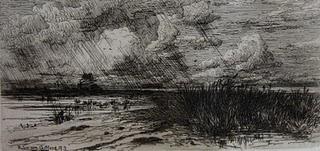 R. Swain Gifford, Summer StormEtching, 1879
R. Swain Gifford, Summer StormEtching, 1879I've been developing an interest in the artists of the New York Etching Club, and intend to devote individual posts to several of them. It seems to me that in embracing the art of etching, with its intrinsic affinity with a more sketchy and impressionistic style of art, these artists laid one of the foundation stones of American Impressionism (and, indeed, they were very shortly joined by such giants of that movement as John Henry Twachtman and J. Alden Weir). They were not, however, looking to the Impressionists for inspiration; instead, their artistic models were the painter-etchers of the earlier Barbizon School, themselves precursors of Impressionism.
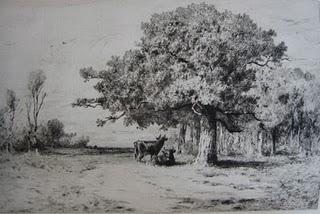 R. Swain Gifford, A Woodland PastureEtching, 1888
R. Swain Gifford, A Woodland PastureEtching, 1888It seems appropriate to start these posts with the artist who etched that "first-born" plate, R. Swain Gifford. Robert Swain Gifford was born on Naushon Island off Cape Cod in 1840, but when he was very young his family moved to New Bedford, Massachussetts. Showing an early talent for art, he studied under the Dutch marine painter Albert van Beest, then resident in New Bedford. Working as R. Swain Gifford, he achieved an international reputation for his oils, watercolors, and etchings.
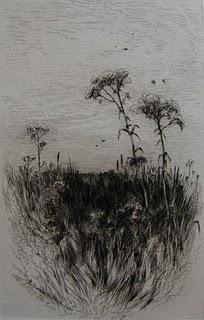 R. Swain Gifford, FlowersEtching, 1880
R. Swain Gifford, FlowersEtching, 1880Gifford produced his first etchings in 1865 or 1866, but like many etchers of this date his interest petered out. Etching materials were hard to come by, there were no specialist printers, no community of interest, and no market for the end result.
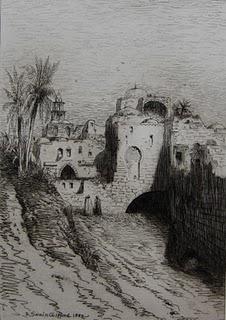 R. Swain Gifford, PalestineEtching, 1880
R. Swain Gifford, PalestineEtching, 1880Despite travels to England, France, Spain, Italy, and perhaps most importantly North Africa and the Sahara Desert, R. Swain Gifford remains best known for his studies of his native New England. The etching "Coal-Pockets at New Bedford", for instance, was one of many local studies produced in the summer months when Gifford retreated from the city to his residence in Nonquitt, six miles from his childhood home of New Bedford.
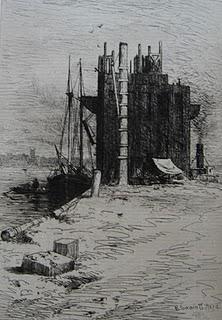 R. Swain Gifford, Coal-Pockets at New Bedford, Mass.Etching, 1879
R. Swain Gifford, Coal-Pockets at New Bedford, Mass.Etching, 1879One interesting feature of the Coal-Pockets etching is Gifford's choice of an industrial subject. Although the aesthetics of the image treat the coal storage tower as if it were a lonely windmill or ruined castle, it is still refreshing to find the modern world, and the world of work, represented in a New York Etching Club etching. Despite the name of the club, the city of New York had to wait for the Ashcan artists to be preferred as subject matter over the New York Etchers' endless romantic landscapes and seascapes.
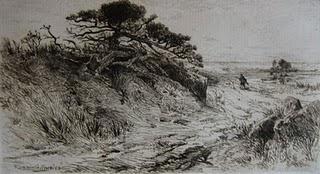 R. Swain Gifford, The Path by the ShoreEtching, 1879
R. Swain Gifford, The Path by the ShoreEtching, 1879For all their conservative ideas about artistic subjects, the etchers of the New York Etching Club introduced a new rhythmic freedom of line and a new freshness of treatment into American art. The critic Sylvester Rosa Koehler wrote of R. Swain Gifford's etchings that, "He has learned to a high degree the art of saying much with little, and therefore makes every line tell." Gifford shows himself at his best, I think, in the atmospheric Summer Storm, and at his least interesting in the facile romanticism of The Baron of St. Castine.
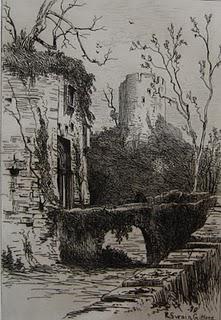 R. Swain Gifford, The Baron of St. CastineEtching, 1979
R. Swain Gifford, The Baron of St. CastineEtching, 1979Robert Swain Gifford died in 1905.

